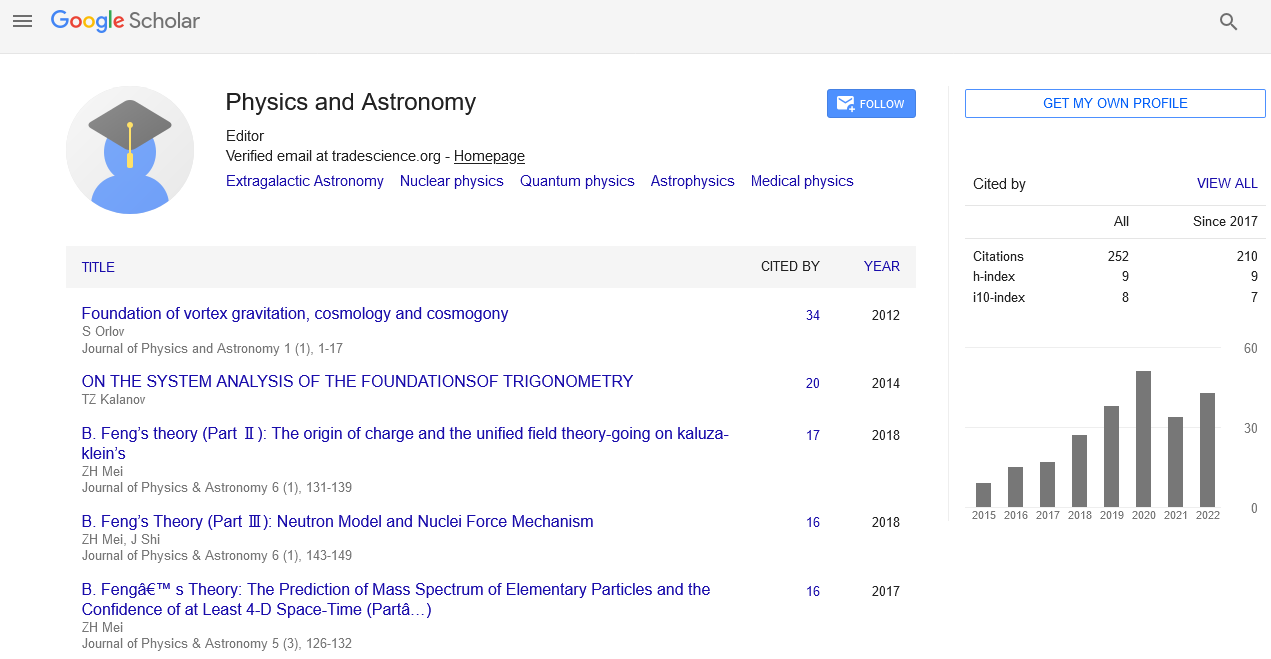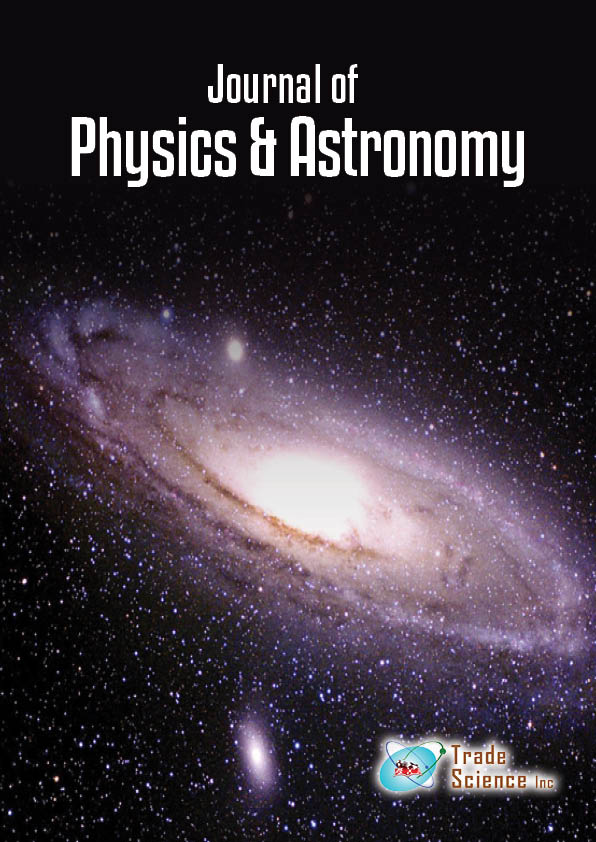Perspective
, Volume: 12( 10)Are CMB Derived Cosmological Parameters Affected by Foregrounds Associated to Nearby Galaxies?
- *Correspondence:
- Anne Rice Department of Mathematics and Physics, University of West Indies, Barbado, E-mail: riceanne@gmail.com
Received date: Oct-15-2024, Manuscript No. tspa-24-152524; Editor assigned: Oct-17-2024, Pre-QC No. tspa-24- 152524 (PQ); Reviewed: Oct-19-2024, QC No. tspa-24-152524 (Q); Revised: Oct-21-2024, Manuscript No. tspa-24- 152524 (R); Published: Oct-25-2024, DOI. 10.37532/2320-6756.2024.12(10).340
Citation: Rice A. Are CMB Derived Cosmological Parameters Affected by Foregrounds Associated to Nearby Galaxies? J. Phys. Astron.2024;12(10):340.
Abstract
We perform cosmological parameters estimation on Planck Cosmic Microwave Background (CMB) maps masking the recently discovered foreground related to nearby spiral galaxies. In addition, we also analyse the association between these foreground regions and recent claims of cosmological causal horizons in localized CMB parameter estimates. Our analysis shows consistent cosmological parameter values regardless of the masking approach, though reduced sky areas introduce larger uncertainties. By modelling the new extragalactic foreground, we identify a resemblance with local parameter variation maps with a statistical significance at the 3 sigma level, suggesting that a simplified foreground model partially accounts, (40-50)% correlation with 15% uncertainty, for the observed causal horizons. These findings add new evidence to the existence of the new foreground associated with large spiral galaxies and show that estimates of cosmological parameters on smaller patches on the sky can be largely affected by these foregrounds, but that the parameters taken over the full sky are unaltered.
Introduction
Extragalactic astronomy is the branch of astronomy that focuses on the study of objects and phenomena beyond our own Milky Way galaxy. This includes the study of other galaxies, galaxy clusters, superclusters, and the large-scale structure of the universe, as well as the forces and processes that shape them. Extragalactic astronomy provides insight into the fundamental processes that govern the evolution of galaxies, the nature of dark matter and dark energy, and the broader dynamics of the universe.
The expanding universe: One of the most profound conclusions drawn from extragalactic studies is that the universe is expanding. This was first demonstrated by Edwin Hubble's observation that distant galaxies are receding from us, a discovery that led to the formulation of the Big Bang theory of cosmology. Galaxy interactions and mergers play a critical role in shaping their structure and star formation histories [1-4].
Dark matter and dark energy: Observations of galaxies and galaxy clusters provide strong evidence for the existence of dark matter, a form of matter that does not emit or interact with electromagnetic radiation but has mass, influencing gravitational effects. Furthermore, the accelerated expansion of the universe suggests the presence of dark energy, a mysterious force that is driving this acceleration.
Supermassive black holes: Supermassive black holes are found at the centers of most galaxies, and their growth appears to be intimately connected with the formation and evolution of the host galaxies. Active Galactic Nuclei (AGN) and quasars are important phenomena associated with these black holes, emitting enormous amounts of energy [5].
Cosmic large-scale structure: Extragalactic astronomy has revealed the large-scale structure of the universe, which includes vast "cosmic webs" of galaxy clusters and voids. These structures trace the distribution of matter across billions of light-years and provide insights into the early universe and the forces that have shaped its evolution.
Cosmic distance ladder and measurement: Measuring distances to far-off galaxies has been an ongoing challenge in extragalactic astronomy. The development of reliable distance indicators, such as Cepheid variables, Type Ia supernovae, and redshift measurements, has been crucial in determining the size, age, and fate of the universe.
The role of supernovae in cosmology: Type Ia supernovae have become critical tools for measuring cosmological distances and for studying the rate of expansion of the universe. Their consistent luminosity makes them "standard candles" for distance measurement, leading to the discovery of dark energy and providing a better understanding of the universe's acceleration.
Intergalactic medium and galaxy evolution: The space between galaxies—the Intergalactic Medium (IGM)—is populated by hot, diffuse gas that influences the evolution of galaxies and the formation of large-scale cosmic structures. Studies of the IGM, including through the detection of hydrogen in the Lyman-alpha forest, have provided valuable insights into the early universe and the processes that led to the formation of galaxies [6,7].
Conclusion
Extragalactic astronomy is the branch of astronomy that studies objects and phenomena beyond our Milky Way galaxy, including other galaxies, galaxy clusters, supermassive black holes, dark matter, and the large-scale structure of the universe. The field has made tremendous advances in recent decades due to improvements in observational techniques, such as the development of advanced telescopes and space observatories, along with sophisticated theoretical models. Extragalactic astronomy has transformed our understanding of the universe, providing a detailed picture of galaxy formation and evolution, the large-scale structure of the cosmos, and the mysterious components like dark matter and dark energy that shape the fate of the universe. As observational technology advances, future studies will continue to deepen our knowledge, potentially answering fundamental questions about the origin, structure, and ultimate destiny of the cosmos.
References
- Cameron P. The Penrose property with a cosmological constant. Class Quantum Gravity. 2022;39(11):115002.
- Kerr RP. Do black holes have singularities? 2023;10.
- Schindler JC, Aguirre A. Algorithms for the explicit computation of Penrose diagrams. Class Quantum Gravity. 2018;35(10):105019.
[Google scholar] [Crossref].
- Horowitz GT. Black holes in higher dimensions. Camb Univ Press. 2012
- Taylor EF, Wheeler JA. Exploring black holes. San Franc Addison Wesley Longman.
[Google scholar] [Crossref]
- Aly F, Stojkovic D. On the generalization of the Kruskal–Szekeres coordinates: a global conformal charting of the Reissner–Nordström spacetime. Class Quantum Gravity. 2024;41(13):135005.[Google scholar]
- Giddings SB. The black hole information paradox. 1995

